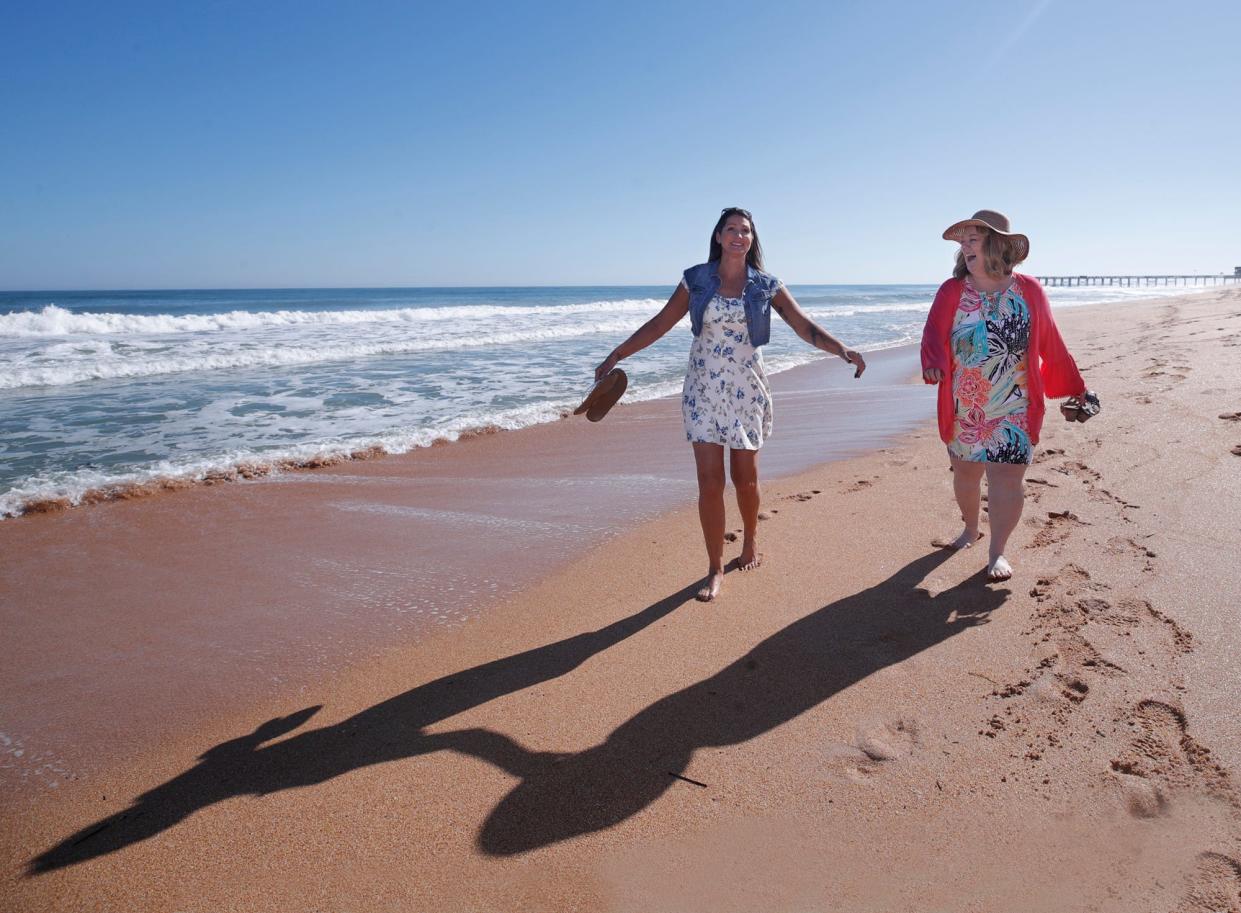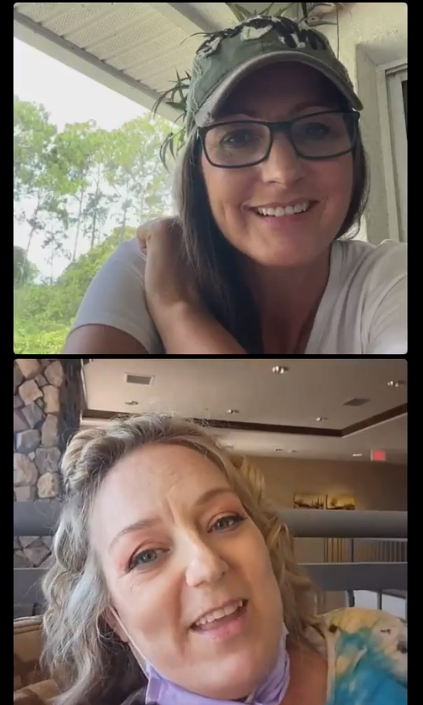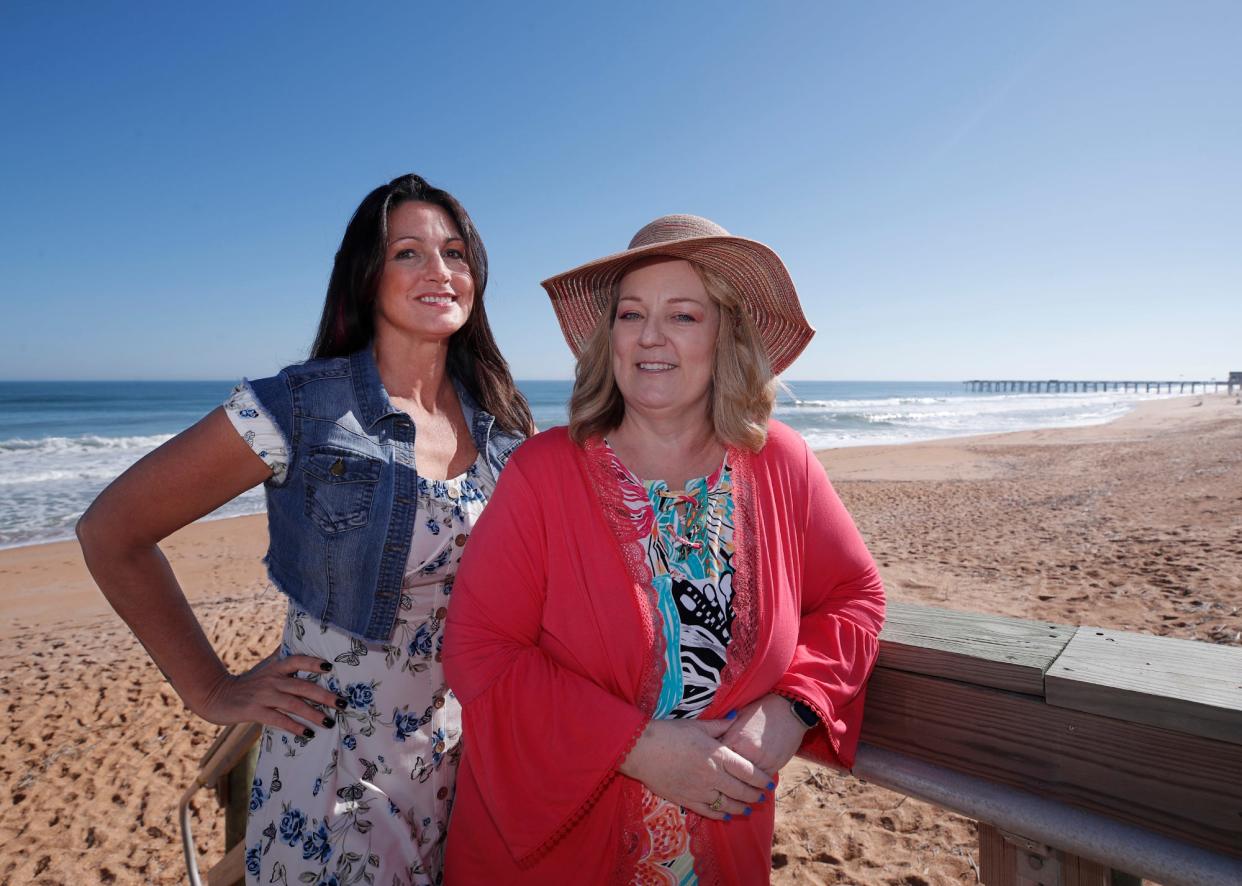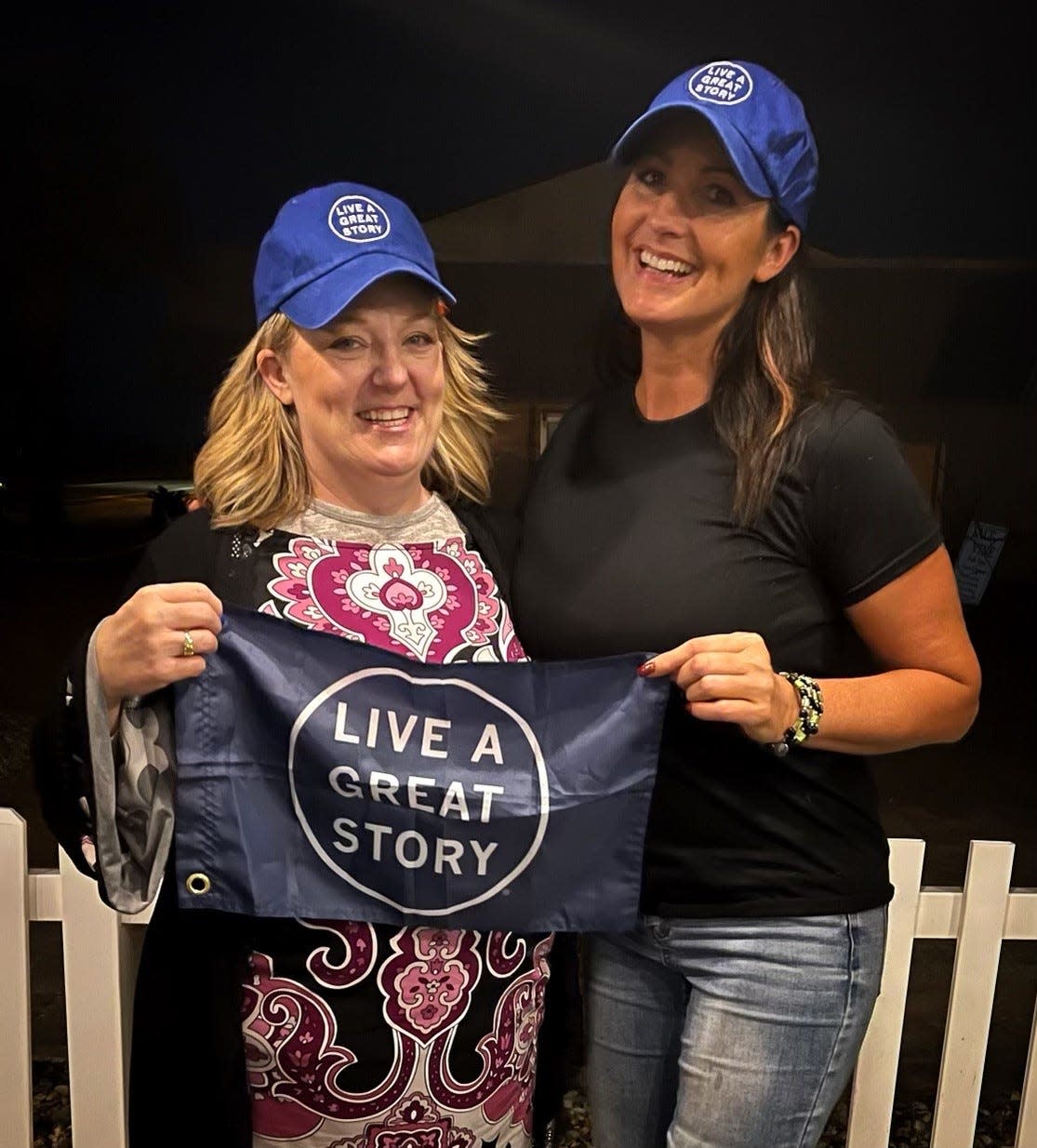“I’d give my kidney for a …”
It’s not the most common idiom being bandied about, but you hear it from time to time, as a means of expressing a strong desire. Rarer, still, is the person who says, “I’d give my kidney.” Period. No qualifiers.
Dawn Fowler, one of 92,000 Americans on the United Network for Organ Sharing list waiting for a transplant, found such a person. Tracy Miley, a Florida health coach, literally gave her kidney to a long-lost high school classmate living 2,000 miles away last July before the two − now both on the mend − reunited recently in Florida.
‘A new life’ in Arizona
Miley − then Tracy McKinley − and Dawn Lynch graduated from Clinton High School in Clinton, Iowa, on the Mississippi River, in 1988. They weren’t close friends, but sang together in the choir and had known each other since 6th grade.
All those years ago, they went their separate ways. Within two years, Lynch − now Dawn Fowler − had given birth to her first son and was getting out of a relationship.
“I had a 7-month-old baby and a diaper bag and a suitcase and I left everything behind to come (to Arizona) and be with my mom and dad, and just start a new life.”
That life included marrying her husband Bill in 1997, and raising her two sons, Jesse Lynch and Joshua Fowler, now 32 and 22. Fowler lives in Buckeye, west of Phoenix, and is an asset manager for homeowners’ associations.
Sleep habits change:Sleeping 5 hours or less could prompt risk of chronic diseases later in life, study says
‘There’s a shared connection’: California transplant recipient’s journey inspires career in nutrition
‘Doesn’t make sense’: For Black Americans, lack of ‘rigorous scientific evidence’ led to test that leaves some off kidney transplant list
Four years ago, Dawn Fowler wasn’t sleeping right, getting up four or five times a night. Aching all over. Swelling in her feet and legs. “Miserable,” she said.
On Oct. 28, 2018, she learned she had chronic kidney disease (CKD). Her condition, she later learned, was known as IgA nephropathy, which results from the buildup of the antibody immunoglobulin (IgA), causing inflammation that, in effect, suffocates the kidney.
While the long-term solution was a kidney transplant, the immediate treatment was hemodialysis, getting hooked up to a machine that cleans the blood for several hours three times a week. Both the disease and the treatment were hard on Fowler, who was contemplating her mortality and getting her “house in order,” by writing a will and preparing estate planning.
Volleying to Florida
Meanwhile, Miley, who had been a first-team all-state volleyball player for Clinton High, went to the University of Oklahoma to play for the Sooners before transferring to Viterbo University, a small Catholic college in LaCrosse, Wisconsin. Eventually, she met her husband JT in Georgia, marrying in 1998. With his two daughters from a previous relationship, and their son Jacob, the Mileys have made a life in Florida since 2001.
A self-described “empath,” Tracy Miley worked as a paraprofessional in public schools, then later as a job coach, helping students with disabilities, autism and behavioral disorders prepare for life as adults.
When she decided to step up her own fitness during the pandemic, she changed careers, becoming a health coach, helping elevate not just her own strength, but that of others. Little did Miley know that would help put her in a better position to save someone’s life.
“It helped me to get in a better place, physically, where I could help (Fowler),” Miley said. “If I hadn’t, I wouldn’t have been a candidate to help her.”
Fowler, meanwhile, was struggling with her weight and health. Because she wanted a kidney, and getting one would require her to be in physical condition for a life-altering surgery, she started losing weight, getting healthier. That involved eating better. “Whatever I can do to improve myself.”
‘A bridge between hearts’: How three Jewish and Arab families swapped kidneys, saved their mothers and made history
The algorithm that made a transplant possible
Their paths led both women to common interests they fed into Facebook, where they’d connected as old high school mates commonly do.
“I was sharing a lot of positive, encouragement, strong women, better health in general,” Fowler said, turning to Miley. “And then you started coming into my feeds.”
Miley responded: “Because I share the same kinds of things: It’s all about positivity. It’s about uplifting and health.”
Despite her efforts to regain health, Fowler’s kidney glomerular filtration rate (GFR) had declined from 35 when she first learned she had CKD, to 6. A GFR of 60 or greater is considered normal for a woman her age.
Fowler posted about needing a living kidney donor, someone with O-positive blood.
Miley happened to see the post. The live donor seed was planted.
“I had no idea that was a thing,” she said. “I thought you only donated after you died.”
Miley, who was listed as an organ donor, started gathering information about becoming a living donor.
What drives a person to become a living donor?
Miley didn’t make her intentions known to Fowler at first.
“I didn’t want to get your hopes up,” she said to Fowler. “And I didn’t really know if I could do it. I had to get the information first.”
Once she did tell Fowler she was seriously considering donating her kidney, Fowler was grateful. “Why did you choose me?” she asked.
Initially, Miley didn’t fully know. Her friend was hurting. Maybe she could help.
“I have O-positive blood,” she thought. “What would this be like? … I have big empath kind of qualities and I felt really, really bad for her.”
Later, she connected the desire to give of herself to a tragedy from her past.
“Nineteen years ago, maybe, I was a surrogate for a couple. And that’s something else (people ask) ‘Why would you do that?’ I don’t know. I loved being pregnant,” Miley said.
But she didn’t want to raise any more children herself. When Miley learned of a couple that was struggling to get pregnant, she had this reaction: “It’s not fair. It’s not fair that I can have a baby and they can’t.”
So she volunteered to carry the couple’s fertilized egg, which produced twins.
“Five months in, I went into early labor and lost them both. It was traumatic. It was horrible,” she said.
“So that hurt me to the core for a very long time. I felt like a failure, even though there just wasn’t anything I could do,” Miley said. “But I think there’s a part of me (where) that need to help didn’t get fed.”
By being a living donor, Miley had control over who would get her kidney.
“I kind of wanted to, selfishly, be around and see. I want to see where my organ is going to go,” she said. “I wanted to see somebody change their life.”
A match and a breathtaking text
For months, Miley endured doctor visits after medical tests after more doctor visits. There were blood tests, full body scans, heart stress tests, a colonoscopy, a gynecological test, nuclear medicine imaging, ultrasounds, psychological evaluations, a consultation with a dietitian and COVID tests.
Fowler told Miley: “It absolutely tested you. It tested your patience, your frustrations.”
In dialysis, Fowler faced her own challenges. One time, while paramedics were at her dialysis center to tend to another patient, Fowler felt faint.
“My head felt like it was in a water bowl. I could feel my eyes going,” she said. She passed out with a blood pressure of 65/48.
By July 1 of this year, Miley’s kidney was approved for Fowler.
Miley sent Fowler a text message: “I’m still in it if you still want to do this.”
Fowler’s husband Bill said she showed him Miley’s text.
“She was still crying and couldn’t say anything,” Bill Fowler said.
Just as every medical professional had, Fowler explained to Miley that going through with the donation “absolutely, 100%, has to be your choice.”
“Yep,” Miley responded. “I’m good. Let’s go.”
Miley said the more invested she became, the more she felt at peace.
“I knew this was what I needed to do,” she said.
Here’s looking at you, kidney
About three days before her surgery, Fowler was at Mayo Clinic for bloodwork. As she was leaving, she spotted two hospital workers pushing carts that appeared to be carrying organs.
Fowler, in a wheelchair, got their attention, asking; “Hey, are those kidneys?”
They were.
She asked if she could take a picture.
“Sure,” she was told.
Levity kept both women loose prior to their surgeries.
Miley went under the knife at 5 a.m. July 28 at Mayo Clinic in Jacksonville.
Fowler’s surgery was after 8 p.m. that night at the Mayo Clinic in Phoenix.
Miley’s kidney, said to be big and nicknamed “Sexy,” was flown across the country in a cooler.
“They literally put it in the overhead bin of the plane,” Miley said. “Nobody is with it. Somebody is (at the Phoenix airport) to pick it up.”
Across the country, Fowler waited.
“It didn’t hit me until 15 minutes before the (transplant). … I had such a peace about it,” she said.
When she was told her new kidney had arrived, Fowler became emotional.
“I really just started, like, vibrating,” Fowler said.
Before long, she was on the operating table. Her surgery was about three hours, Bill Fowler said. Miley’s kidney worked right away.
“I had a good kidney,” Miley said.
Fowler responded: “You had a very good kidney.”
A scar and a story
While most kidney donors experience pain for one to two weeks after the surgery, Miley’s was milder than she expected.
A week after giving her kidney away, Miley found herself at Planet Fitness walking on a treadmill. In the second week, she hit a brick wall.
“It wasn’t so much pain, but I was super-super tired. I was so weak,” she said.
But she gradually regained her strength and eagerly shared her experience with friends in Facebook Live videos and posts. Miley hasn’t had to change her diet, which was healthy before the surgery, and she hasn’t had to give up the occasional beer.
To compensate for the loss of one kidney, her other one is in the process of expanding. She doesn’t feel any worse for the wear and talks proudly of her scar, below her belly. “I think it looks pretty good,” she said. “I like my scar.”
New kidney, new life
Fowler’s recovery was more drawn out. At first, she got around in a wheelchair, working her way up to a walker before shedding that in the fourth week.
“I feel so much better now. There’s days where, one, if I overeat, it really, really, drains me. I have to be really careful,” she said. But she can see her health returning in the color of her face. It’s pink, rather than “gray and purple,” she said.
She needs to wait a year before being confident the transplant will work for the long haul, 10 years or more.
With the new kidney and the anti-rejection drugs she must take, Fowler can’t have undercooked food such as sushi, or specific fruits including pomegranate, grapefruit and Seville oranges. She also has to be extra vigilant about germs, as her immune system is weakened.
Fowler remains a bit uncomfortable sharing her story, but she embraces a philosophy Miley credits her sister Dena McKinney-Miller − her post-operation caregiver − with sharing: “Live a Great Story.” At their Florida reunion, the women, bonded by a kidney, posed for a photo wearing caps and holding up a flag with that motto.
Fowler is hoping that “great story” inspires other people to consider becoming live donors to those in need of kidney transplants, even as she grapples with the magnitude of Miley’s gift.
“What do you give your donor? My gratitude. My life story,” she said. “Oh, man, that makes me cry.”
And what does the donor expect?
“Nothing. I don’t expect anything,” Miley said.
So looking ahead, Fowler said she is hoping to pay it forward by taking on a larger role with the IgA Foundation and sharing her story. Thousands remain on the transplant list seeking kidneys.
This article originally appeared on USA TODAY: Kidney transplant reunites Florida, Arizona classmates 35 years later
Source: Read Full Article



